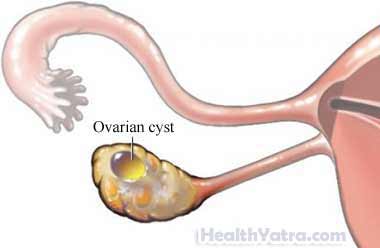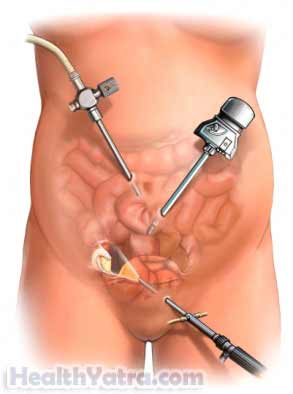تعريف
This is surgery to remove a cyst on an ovary.

أسباب هذا الإجراء
An ovarian cyst may need to be removed if it is:
- Suspected of being cancerous (the chances are lower if you are young)
- Large (more than 2.5 inches in diameter)
- Solid (rather than containing just fluid)
- Causing pain
المضاعفات المحتملة
Complications are rare, but no procedure is completely free of risk. If you are planning to have an ovarian cyst removed, your سيقوم الطبيب بمراجعة القائمة من المضاعفات المحتملة، والتي قد تشمل:
- العدوى
- نزيف
- Cyst returns after it is removed
- Need for removal of one or both ovaries
- العقم
- Blood clots
- الأضرار التي لحقت الأجهزة الأخرى
تشمل العوامل التي قد تزيد من خطر حدوث مضاعفات ما يلي:
- السمنة
- Chronic or recent illness
- Heavy use of alcohol, smoking, or use of narcotics (may make delivering anesthesia more difficult or impair wound healing)
- Use of certain prescription medicines
- حمل
- جراحة سابقة في البطن
تأكد من مناقشة هذه المخاطر مع طبيبك قبل الإجراء.
ما يمكن توقعه
قبل الإجراء
قد يقوم طبيبك بما يلي:
- اختبار بدني
- استعراض الأدوية
- تحاليل الدم
- Urine test
- CT scan —a type of x-ray that uses a computer to make pictures of organs
- Ultrasound —a test that uses sound waves to examine the abdomen
- Electrocardiogram (ECG, EKG)—a test that records the heart’s activity by measuring electrical currents through the heart muscle
Talk to your doctor about what action should be taken if cancer is found during surgery. One option is to remove the ovary.
قبل الجراحة:
- التحدث مع طبيبك عن الأدوية الخاصة بك. قد يطلب منك التوقف عن تناول بعض الأدوية تصل إلى أسبوع واحد قبل العملية مثل:
- الأسبرين أو غيره من العقاقير المضادة للالتهابات
- مخففات الدم ، مثل الوارفارين (الكومادين)
- كلوبيدوجريل (بلافيكس)
- Arrange for a ride to and from the hospital. Also, arrange for someone to help you at home.
- Do not eat or drink for at least eight hours before the surgery.
التخدير
- التخدير العام - يمنع الألم ويجعلك نائمًا أثناء الجراحة؛ يتم إعطاؤه من خلال الوريد في يدك أو ذراعك
- Local anesthesia—just the area that is being operated on is numbed; given as an injection and may also be given with a sedative
وصف الإجراء
The doctor will make a small incision just below the navel. Next, the doctor will insert a laparoscope. This is a thin tube with a camera on the end. To allow the doctor to better view the organs, carbon dioxide gas will be pumped into the abdomen. The laparoscope will be used to locate the cyst. Once found, the doctor will make one or two more incisions. Surgical tools will be inserted to remove the cyst. The doctor may remove tissue for testing. If cancer is found, both ovaries may need to be removed. Once the cyst is removed, the doctor will remove the tools. The incision area will be closed with stitches or staples.
In some cases, the doctor may switch to an open جراحة. He will make a large incision in the abdomen to do the surgery.

مباشرة بعد الإجراء
After the procedure, you will be given IV fluids and medicines while recovering.
كم من الوقت سيستغرق ؟
1-2 ساعة
هل سيكون هناك ألم؟
There will be pain after the surgery. Your doctor will give you pain medicine.
متوسط الإقامة في المستشفى
You may stay overnight, or you may be able to leave the hospital the same day as your surgery.
رعاية ما بعد العملية
Recovery may take 1-2 weeks. When you العودة إلى المنزل، قم بما يلي للمساعدة في ضمان التعافي السلس:
- تأكد من اتباع تعليمات طبيبك .
- اسأل طبيبك حول, عندما هي آمنة للاستحمام, السباحة, أو نقع في الماء.
- Gently wash the incision area with mild soap and water.
- Move and elevate your legs while in bed. This will lessen the chance of blood clots.
- Take prescription pain medicine only for as long as needed. Take over-the-counter pain relievers (eg, ibuprofen , naproxen ) if the pain is mild.
- Avoid strenuous exercise for 2-6 weeks.
- Do not drive until your doctor says it is safe.
- Do not resume النشاط الجنسي until your doctor says it is okay. You may need to wait two weeks.
- Follow your doctor’s guidelines for ultrasound tests. These may need to be done if it is likely that the cysts will return.
استدعاء الطبيب
بعد مغادرة المستشفى، اتصل بطبيبك في حالة حدوث أي مما يلي:
- علامات الإصابة, بما في ذلك حمى وقشعريرة
- احمرار أو تورم أو ألم متزايد أو نزيف مفرط أو إفرازات من موقع الشق
- ألم لا يمكنك السيطرة عليه بالأدوية التي أعطيت لك
- Increased vaginal bleeding or discharge
- السعال وضيق التنفس وألم الصدر
- الغثيان و / أو القيء الذي لا يمكنك السيطرة عليه بالأدوية التي أعطيت لك بعد الجراحة ، أو التي تستمر لأكثر من يومين بعد الخروج من المستشفى
- Headaches, muscle aches, dizziness, or general ill feeling
- Constipation or abdominal swelling
- القيء
- Urinary difficulties
- Onset of pain or swelling in one or both legs
- أعراض جديدة غير مبررة
في حالة الطوارئ ، اتصل على المساعدة الطبية على الفور.
